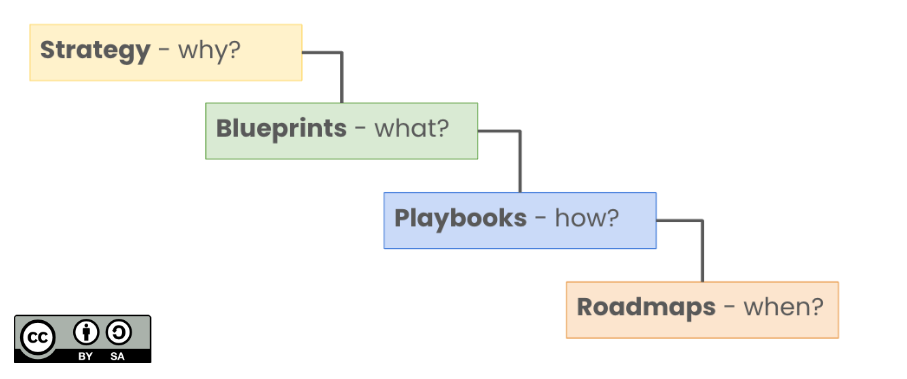This post and all its contents is published under a creative commons attribution-sharealike license. Find out more⬈.
I’m doing a fair bit of strategy work with councils at the moment, and have hit upon a framework for putting them together which seems to help keep strategies strategic, and thus make them more useful.
I’m typing here about the work I’m doing on digital strategies specifically – although this stuff may well work for other kinds of strategies too. Also, this isn’t a ‘do you need a digital strategy?’ kind of post – it assumes you’ve decided you do need one. Finally, when I say digital, I mean it as a shorthand for technology, data, and online experience. OK, let’s get into it!
Strategy sometimes has a bad reputation – and that’s probably because a lot of strategies aren’t very good!
- They don’t align with any other strategic vision
- They are too detailed
- They are written in weird corporate speak and fail to engage people
- They try to do too many things
- They date really badly
- Nobody reads them, or refers to them
What does good strategy look like?
- Good strategies provide a destination for organisations. They describe why things need to be different in the future.
- With that vision, individual teams can use them to plan what they will do, when they will do it, and how they will deliver.
- Strategies aid decision making, prioritisation, architectural decisions, team structures, culture, ways of working… pretty much everything! But, importantly, they don’t need to include the details of those things.
My approach to making this all a lot easier is to do the following:
- Really focus on what exactly the strategy needs to do. Keep it short, high level, outcomes focused
- Resist the temptation to put operational details or project plans into strategies – ie the stuff that’s likely to change
- Have proper documents where that stuff can go, to ensure it still gets thought about and written down

Explaining the framework
The way this works is that all the stuff that often (wrongly, in my view) ends up in strategies is actually published in 4 separate documents (or not documents – could be any format depending on the content).
It also ensures we can be flexible with the bits that need to be flexible. Plans change, technology changes, stuff happens. That shouldn’t affect your strategic vision, themes, and principles – but it will and should change your choices, pipeline of work, and approaches to doing work.
- This strategy is high level and long term. It outlines the outcomes expected from the strategy and answers the question ‘why?’. The strategy is the formal document, which is formally adopted by the Council and will rarely if ever change.
I’m thinking of this as a maybe 6 page document (maybe more to allow for the senior person’s introduction, etc etc). It is vital that it is properly socialised across the entire organisation and referred to all the time. Maybe find a way to pull bits out of it to go on posters and things, to keep them in folk’s minds. - Blueprints are created individually for different elements of the strategy, such as core ICT, applications, data or online experience. They provide a link between strategy and delivery. They answer the question ‘what?’. They are likely to change as decisions are made around the issues involved.
Blueprints are likely to come in a variety of formats. Could be enterprise architecture type diagrams, could be statements of approach, could be policu documents, could be organisation charts. All depends what bits of the mechanisms of strategy delivery you’re articulating. - Playbooks define the ways of working and approaches to delivering the work. They answer the question ‘how?’. They ought to be truly living documents that evolve as the organisation gets better and more mature in their approach to doing digital related work.
I think the best playbooks tend to be online and easy to refer to. So, could be on the intranet, or on a blogging platform, or using something like Gitbook⬈. It’s important that it’s easy to access and easy to update and add to. - Roadmaps are created individually for each theme. They describe the activities to deliver the strategy outcomes, in other words, the ‘when?’. It’ll be updated all the time, as prioprities switch around, things take longer to deliver than expected, or where emergencies arise.
The nice way to do a roadmap would be with some nice software to make it pretty – there are loads out there. But it could be a Gantt chart type thing, or a simple portfolio list that shows when things are planned in to be done.
Hopefully that makes sense. The idea is simple – keep the strategy strategic, and make sure everyone understands it. All the detail still needs documenting, but in the appropriate place and in an appropriate format.
Let me know what you think!

Good stuff, Dave. At WAO we start almost every new bit of work using “who, what, when, where, why, and how” – optionally singing along to the Busytown Mysteries theme song: https://www.youtube.com/watch?v=d9pftOJW0uk 🙂
I like this Dave – I think of strategy as a little bit more than the why… I keep picking up and putting down the book Good Strategy/Bad Strategy by Richard Rumelt which seems to have aged surprisingly well and has some useful thoughts on the topic. I very much agree though that less is often more in this space!
What I like about your framework is that you are explicitly calling out other artefacts where the what, how and when can live and have value. Often you see organisations expending so much effort on the strategy at the expense of these things.